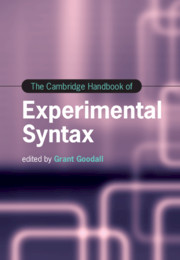Book contents
- The Cambridge Handbook of Experimental Syntax
- The Cambridge Handbook of Experimental Syntax
- Copyright page
- Contents
- Figures
- Tables
- Contributors
- Introduction
- Part I General Issues in Acceptability Experiments
- 1 Sentence Acceptability Experiments: What, How, and Why
- 2 Response Methods in Acceptability Experiments
- 3 Approaching Gradience in Acceptability with the Tools of Signal Detection Theory
- 4 Variation in Participants and Stimuli in Acceptability Experiments
- 5 Acceptability, Grammar, and Processing
- 6 Satiation
- 7 Acceptability (and Other) Experiments for Studying Comparative Syntax
- Part II Experimental Studies of Specific Phenomena
- Part III Experimental Studies of Specific Populations and Language Families
- Part IV Experimental Syntax beyond Acceptability
- Index
- References
7 - Acceptability (and Other) Experiments for Studying Comparative Syntax
from Part I - General Issues in Acceptability Experiments
Published online by Cambridge University Press: 16 December 2021
- The Cambridge Handbook of Experimental Syntax
- The Cambridge Handbook of Experimental Syntax
- Copyright page
- Contents
- Figures
- Tables
- Contributors
- Introduction
- Part I General Issues in Acceptability Experiments
- 1 Sentence Acceptability Experiments: What, How, and Why
- 2 Response Methods in Acceptability Experiments
- 3 Approaching Gradience in Acceptability with the Tools of Signal Detection Theory
- 4 Variation in Participants and Stimuli in Acceptability Experiments
- 5 Acceptability, Grammar, and Processing
- 6 Satiation
- 7 Acceptability (and Other) Experiments for Studying Comparative Syntax
- Part II Experimental Studies of Specific Phenomena
- Part III Experimental Studies of Specific Populations and Language Families
- Part IV Experimental Syntax beyond Acceptability
- Index
- References
Summary
In this chapter, I discuss the relationship between acceptability judgments and other experimental techniques and the broader goals of comparative syntax. Acceptability judgment experiments quantify the impact that a small number of factors exert on acceptability across a sample of participants. By contrast, comparative syntax has typically sought to characterize systematic similarities and differences between grammatical systems, on various scales of abstraction (languages, dialects, individual grammars). In this chapter, I argue that acceptability judgment experiments can contribute to comparative syntax by quantifying subtle judgments within a language as a ”check” on intuitive judgments collected from underresourced languages, by establishing reliable trends across languages, and by exploring individual differences within a population. I emphasize that careful factorial designs, appropriate controls, and previously established, theoretically informed hypotheses are crucial to the success of applying experimental approaches to comparative syntax.
Keywords
- Type
- Chapter
- Information
- The Cambridge Handbook of Experimental Syntax , pp. 181 - 208Publisher: Cambridge University PressPrint publication year: 2021
References
- 1
- Cited by

